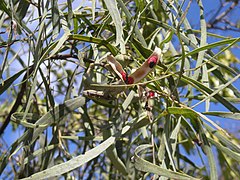Acacia salicina
| Habit | tree
| |
|---|---|---|
| Height: | ⇕ | 15 ft"ft" can not be assigned to a declared number type with value 15. to 35 ft"ft" can not be assigned to a declared number type with value 35. |
| Width: | ⇔ | 10 ft"ft" can not be assigned to a declared number type with value 10. to 17 ft"ft" can not be assigned to a declared number type with value 17. |
| Lifespan: | ⌛ | perennial |
| Bloom: | ❀ | early fall, mid fall, late fall, early winter, mid winter, late winter |
| Exposure: | ☼ | sun |
|---|---|---|
| Features: | ✓ | flowers |
| USDA Zones: | 8 to 9 | |
| Flower features: | ❀ | orange, yellow |
|
Fabaceae > |
Acacia > |
salicina > |
Common names include Cooba, Native Willow, Willow Wattle, Broughton Willow,Sally Wattle and Black Wattle.
It is a large shrub or small evergreen[1] tree growing 3 to 20 m tall.[2] It has a life span of about 10–15 years. In the Northern Hemisphere, Acacia salicina flowers primarily from October to January and the seed pods are often visible from April to July.[3] The tree's seeds are shiny, black and have a crimson appendage-like aril.[4] Acacia salicina is "closely related" to Acacia ligulata[5] and Acacia bievenosa.[6]
Read about Acacia salicina in the Standard Cyclopedia of Horticulture
|
|---|
|
Acacia salicina, Lindl. Small tree; branches drooping: foliage pale; phyll. 2-5 in. long, 1/4-1/2in. wide, oblong-linear or lanceolate, narrowed at base, thick, rigid, with a curved point; midrib and marginal veins scarcely prominent: racemes short, often reduced to 2 or 3 heads, or even only 1; peduncles slender; fls. about 20 in the head: pods straight, 1-3 in. long, 1/4in. broad, valves convex, hard and thick; seeds longitudinal; funicle thickened and usually scarlet almost from the base, forming several folds under the seed.—The timber is dark brown and tough, taking a high polish. It is a good forage plant and on this account is becoming scarce in the wild state. Var. Wayae, Maiden. A shrub 8 ft. tall, which blooms sparingly at various times during the year: phyll. somewhat thick (flat when dried) and succulent-looking, oblong-linear, narrowed at base, l 1/2-2 1/2in. long, less than 1/4in. wide; 1 central nerve ending in oblique point; gland below middle: fls. solitary or in pairs, or occasionally in short racemes of 3-5 fls.; sepals united, truncate; petals 5: pod 1-2 in. long, less than 1/4in. broad, contracted between the seeds; seed longitudinal; funicle scarlet its entire length, folded several times at one end of seed; ripe June-Sept. Fls. Feb.-May.—A neat little shrub with bright green lvs. The pods must be picked as soon as ripe and just before dehiscence, for the elastic opening of the pod will discharge the seed in every direction.
|
Cultivation
- Do you have cultivation info on this plant? Edit this section!
Propagation
- Do you have propagation info on this plant? Edit this section!
Pests and diseases
- Do you have pest and disease info on this plant? Edit this section!
Species
Gallery
If you have a photo of this plant, please upload it! Plus, there may be other photos available for you to add.
References
- Standard Cyclopedia of Horticulture, by L. H. Bailey, MacMillan Co., 1963
External links
- w:Acacia salicina. Some of the material on this page may be from Wikipedia, under the Creative Commons license.
- Acacia salicina QR Code (Size 50, 100, 200, 500)
- ↑ Gardens At Carefree Town Center - Plant Identification List
- ↑ PlantNet - FloraOnline - Royal Botanic Gardens & Domain Trust, Sydney Australia
- ↑ PDF Ursula K. Schuch and Margaret Norem, Growth of Legume Tree Species Growing in the Southwestern United States, University of Arizona.
- ↑ Species Bank Treatment for Acacia Salicina
- ↑ Fact Sheet for Acacia ligulata
- ↑ WorldWideWattle



